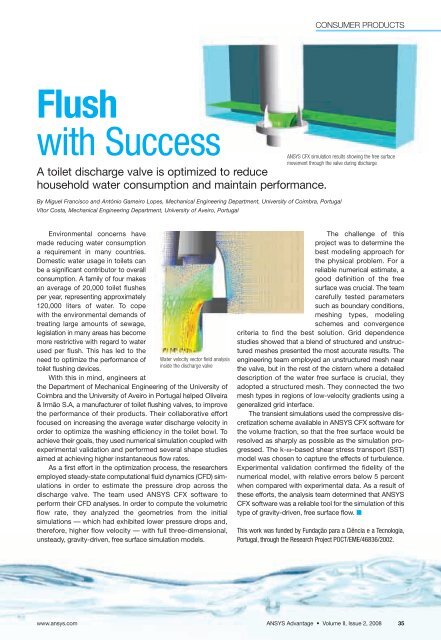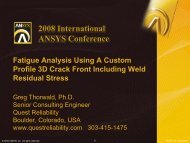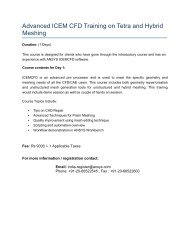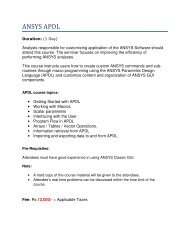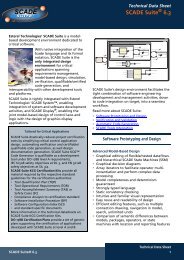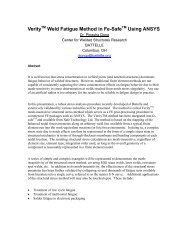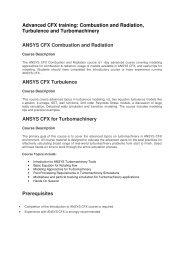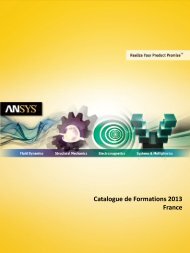Simulation - ANSYS
Simulation - ANSYS
Simulation - ANSYS
Create successful ePaper yourself
Turn your PDF publications into a flip-book with our unique Google optimized e-Paper software.
Flush<br />
with Success<br />
A toilet discharge valve is optimized to reduce<br />
household water consumption and maintain performance.<br />
By Miguel Francisco and António Gameiro Lopes, Mechanical Engineering Department, University of Coimbra, Portugal<br />
Vítor Costa, Mechanical Engineering Department, University of Aveiro, Portugal<br />
Environmental concerns have<br />
made reducing water consumption<br />
a requirement in many countries.<br />
Domestic water usage in toilets can<br />
be a significant contributor to overall<br />
consumption. A family of four makes<br />
an average of 20,000 toilet flushes<br />
per year, representing approximately<br />
120,000 liters of water. To cope<br />
with the environmental demands of<br />
treating large amounts of sewage,<br />
legislation in many areas has become<br />
more restrictive with regard to water<br />
used per flush. This has led to the<br />
need to optimize the performance of<br />
toilet flushing devices.<br />
With this in mind, engineers at<br />
Water velocity vector field analysis<br />
inside the discharge valve<br />
the Department of Mechanical Engineering of the University of<br />
Coimbra and the University of Aveiro in Portugal helped Oliveira<br />
& Irmão S.A, a manufacturer of toilet flushing valves, to improve<br />
the performance of their products. Their collaborative effort<br />
focused on increasing the average water discharge velocity in<br />
order to optimize the washing efficiency in the toilet bowl. To<br />
achieve their goals, they used numerical simulation coupled with<br />
experimental validation and performed several shape studies<br />
aimed at achieving higher instantaneous flow rates.<br />
As a first effort in the optimization process, the researchers<br />
employed steady-state computational fluid dynamics (CFD) simulations<br />
in order to estimate the pressure drop across the<br />
discharge valve. The team used <strong>ANSYS</strong> CFX software to<br />
perform their CFD analyses. In order to compute the volumetric<br />
flow rate, they analyzed the geometries from the initial<br />
simulations — which had exhibited lower pressure drops and,<br />
therefore, higher flow velocity — with full three-dimensional,<br />
unsteady, gravity-driven, free surface simulation models.<br />
CONSUMER PRODUCTS<br />
<strong>ANSYS</strong> CFX simulation results showing the free surface<br />
movement through the valve during discharge<br />
The challenge of this<br />
project was to determine the<br />
best modeling approach for<br />
the physical problem. For a<br />
reliable numerical estimate, a<br />
good definition of the free<br />
surface was crucial. The team<br />
carefully tested parameters<br />
such as boundary conditions,<br />
meshing types, modeling<br />
schemes and convergence<br />
criteria to find the best solution. Grid dependence<br />
studies showed that a blend of structured and unstructured<br />
meshes presented the most accurate results. The<br />
engineering team employed an unstructured mesh near<br />
the valve, but in the rest of the cistern where a detailed<br />
description of the water free surface is crucial, they<br />
adopted a structured mesh. They connected the two<br />
mesh types in regions of low-velocity gradients using a<br />
generalized grid interface.<br />
The transient simulations used the compressive discretization<br />
scheme available in <strong>ANSYS</strong> CFX software for<br />
the volume fraction, so that the free surface would be<br />
resolved as sharply as possible as the simulation progressed.<br />
The k-ω–based shear stress transport (SST)<br />
model was chosen to capture the effects of turbulence.<br />
Experimental validation confirmed the fidelity of the<br />
numerical model, with relative errors below 5 percent<br />
when compared with experimental data. As a result of<br />
these efforts, the analysis team determined that <strong>ANSYS</strong><br />
CFX software was a reliable tool for the simulation of this<br />
type of gravity-driven, free surface flow. ■<br />
This work was funded by Fundação para a Ciência e a Tecnologia,<br />
Portugal, through the Research Project POCT/EME/46836/2002.<br />
www.ansys.com <strong>ANSYS</strong> Advantage • Volume II, Issue 2, 2008 35


